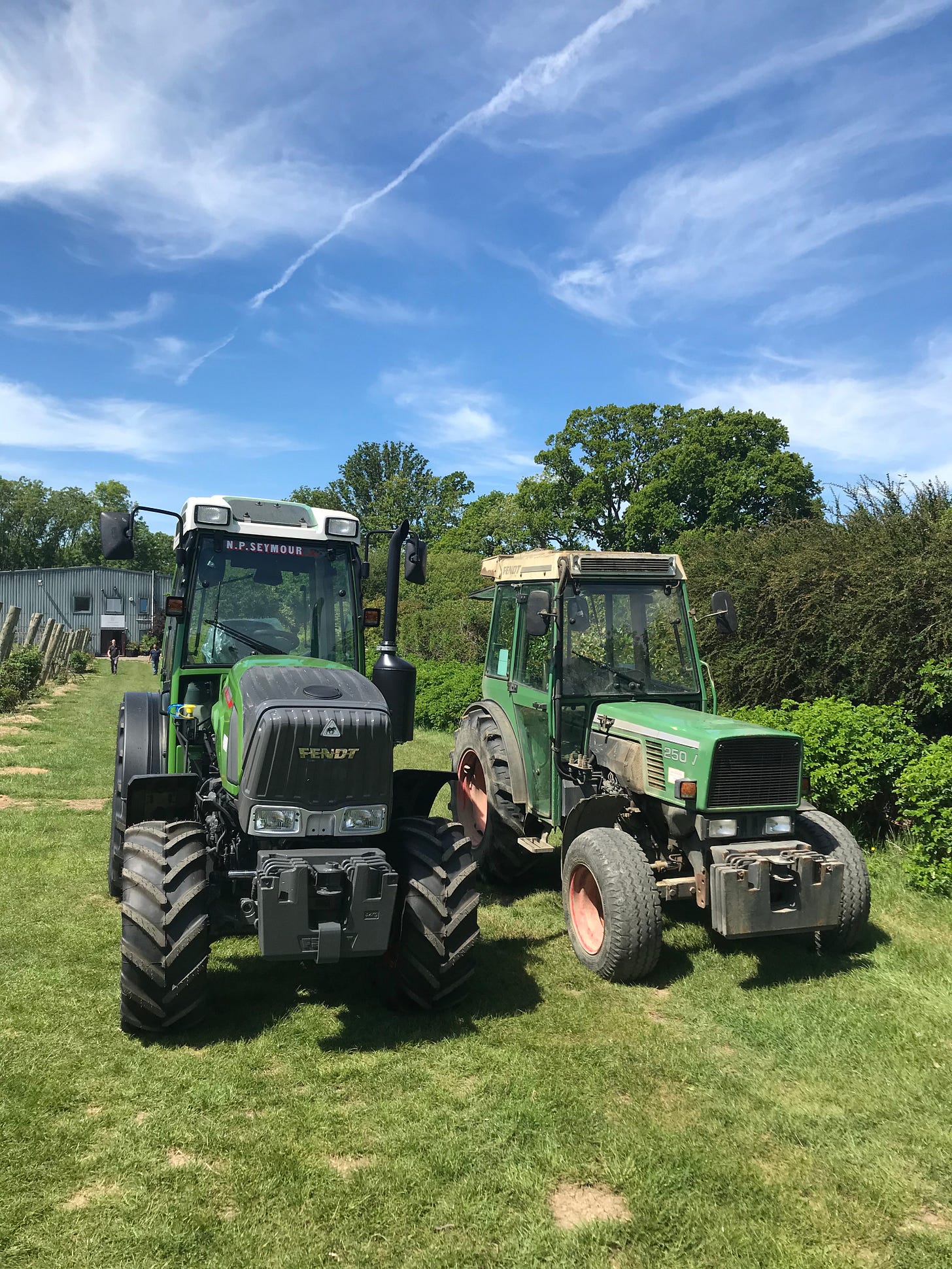I worked on a few vineyards in Australia in 1999. When I came back to England in 2000, I’d made the decision that this was a life I wanted to continue with. A friend told me about a job advert in Farmers’ Weekly for a vineyard in Jersey. Sounded pretty cool, so I called the owner. The only thing I didn’t have was experience driving a tractor in a vineyard. In fact, I didn’t have any tractor-driving experience at all.
I didn’t feel like this was something I could blag my way through. My limited knowledge told me there were too many levers, gears, lifting bits and hydraulics. I wouldn’t have known where to begin.
A few months later, I was enrolled on a two-year HND in Wine Studies at Plumpton College. There I was to learn all about vineyard establishment, pests and diseases, wine sensory skills, winemaking, wine marketing — and of course, vineyard machinery.
So one morning there we were: budding winemakers, potential brand ambassadors, and future vineyard managers like myself, eyeing up a collection of tractors. They were mainly medium-sized farm tractors — perfect for learning the basics. This was what had stopped me applying for that first job, so I was determined to learn. By the end of that first morning, I was hitching up trailers and reversing them through obstacles.
My first mistake was forgetting that normal tractors don’t have suspension. The seat has some sort of suspension, but the wheels don’t. My first trip out on the public highway went fine — the farm track to the vineyard did not. I hit an invisible speed bump at 15 km/h and was sure I nearly defenestrated myself from the cab, via the sunroof.
Driving tractors in vineyards is demanding. At the time you might be thinking, “Well this is rather nice. It’s a sunny day, the aircon is working, and Test Match Special is providing the perfect backdrop.” True — but the level of concentration required is tiring. One advantage is that we work along rows of vines; we’re not having to line up with a tree or fence post at the far end of a field. But stray off-course and it could get expensive.
Navigating vine rows is one thing. In fact, once you’ve settled into it, that becomes the easy bit — regardless of the machine. Turning on tight headlands is another matter. Some vineyards are planted with very tight headlands — by tight, I mean under 8 metres. First, you have to avoid clipping the end-post or anchor cable. So you drive out of the row straight-ish to clear them — but now there’s a fence in front of you, so you have to make the turn. A tractor with a relatively small implement like a flail mower will manage this easily.
But imagine towing a trailer or a sprayer. It can mean doing a three-point turn at the end of every single row. I calculated that on one five-hectare vineyard, these tricky manoeuvres were adding over an hour and a half to a spray round. The headlands were less than 7 metres and the rows weren’t uniform in length. In some areas the only option was to drive around the perimeter of the vineyard and start the next row from the opposite end.
Another thing I’ve witnessed: in a match-up between a vineyard end-post and a tractor door, the end-post wins. The result? A bent metal door frame and glass everywhere. Ever since then, if I have to jump out to check something, I always ensure the door is closed — properly closed, usually twice — before proceeding any further.
That’s why factoring in vineyard layout before planting is so important. How will it work with machinery? Make it as easy as possible. Be generous with turning space. Consider the terrain. Where will the sprayer be filled? Where will the tractor be refuelled?

Over the past couple of decades, I’ve driven quite a few tractors — from a Kubota B6000 mini tractor, old John Deere and Renault orchard tractors, to modern Fendt vineyard tractors. From stiff gearboxes, brakes that require the leg power of a professional cyclist to operate, an old fertliser bag stuffed with straw as a “cushion,” through to modern air conditioning, bluetooth connectivity, touchscreens and complmentary table service. Each has its quirks, but what they all have in common is that they’re not toys — they’re powerful tools that require care, skill, and respect. They do all kinds of work; mowing, spraying, subsoiling, weeding, trimming and a lot more.
Good tractor drivers and machinery operators are worth their weight in gold — the ones who respect the kit and take time to look after it. A careless operator creates frustration and extra work. Mistakes happen — I’ve made plenty — but there’s a difference between learning and not caring. From my perspective, helping people understand the machinery’s capabilities, and allocating time so they’re not rushing or cutting corners, saves many headaches and, most importantly, avoids accidents. This stuff is expensive to buy and usually expensive to fix. Think of a low-mileage Aston Martin DBS, around three years old, and you’d be in the right ballpark. But the modern ones are worth it — more space in the cab (some of the old ones were pretty cramped), better visibility, and air conditioning that actually works. When you’re in one all day, it makes a difference. And if you’re lucky enough to have the right machine and the right person driving it, the vineyard — and your nerves — will thank you.




